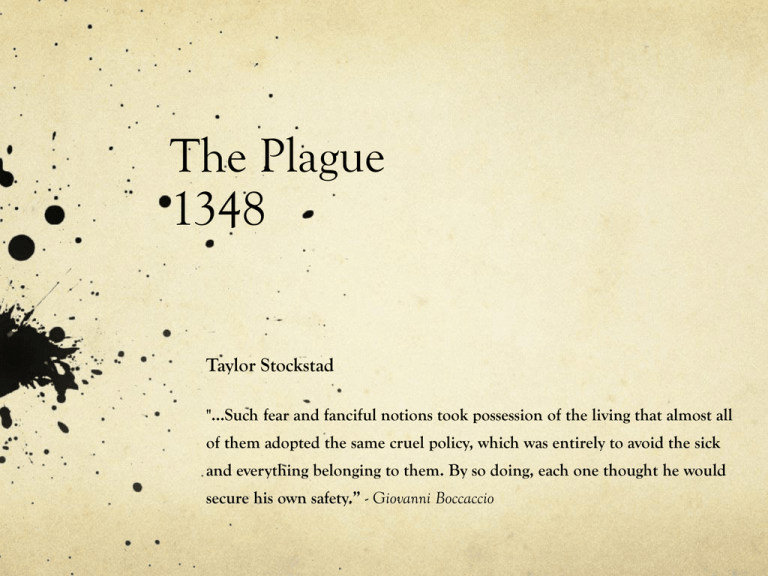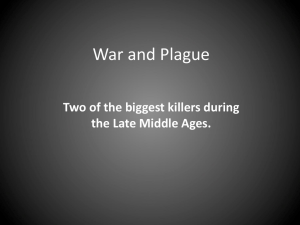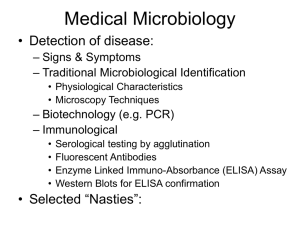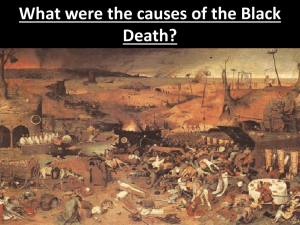The Plague 1938
advertisement

The Plague 1348 Taylor Stockstad "...Such fear and fanciful notions took possession of the living that almost all of them adopted the same cruel policy, which was entirely to avoid the sick and everything belonging to them. By so doing, each one thought he would secure his own safety.” - Giovanni Boccaccio There are three forms of the Plague Bubonic Pneumonic Septicemic I will focus on the Bubonic Plague It derives its name from the swellings or buboes. Europe first experienced the “Black Death” between 1348 and 1350 It is believed the plague originated in Asia, and moved west with Mongol armies and traders. Efforts to Stop the Plague Seemed Useless It had a devastating affect on Europe The Population decreased by 25% to 50% We can still see the memory of its impact today Ring a-round the rosy Pocket full of posies Ashes, ashes! We all fall down! The reservoir of the plague bacteria is normally rodents. The transmission of the Plague from Rodents was caused by the Oriental Rat Flea. There was a complex cycle of Transmission from flea to human. Symptoms of The Bubonic Plague Symptoms normally took around1-7 days to appear Symptoms included: Headaches Nausea Aching joints Fever Vomiting Then. . . A Sign of Impending Death Would Appear These signs were swellings, called buboes, that appeared on a victim's neck, armpits or groin. All forms were caused by a rod shaped bacterium called Yersinia pestis. The Plague bacteria has the ability to avoid the innate immune response, the body's front line of defense. Yersinia Pestis can rapidly kill the host due to it’s machinery. The bacteria can resist phagocytosis by injecting proteins called YOPS (Yersinia Outer Proteins) into macrophages and other immune cells. Thus, it rapidly spreads into the blood stream Reaching to the lymphnodes, where the swelling occurs and killing the host. The Plague still affects the U.S. In the United States during the 1980s plague cases averaged about 18 per year. Most of the cases occurred in persons under 20 years of age. About 1 in 7 persons with plague died. World Wide distribution of the Plague in 1998 An Effective Treatment does Exist Today The drugs of choice are streptomycin or gentamycin, but a number of other antibiotics are also effective. Prevention is an even better approach The Plague Epidemic is still a Big Problem in Developing Countries. Rural and urban areas of developing countries often have problems with rat infestation and are put at a higher risk of bubonic plague. Unfair Distribution of Antibiotics is the Cause. Bibiliography http://www.eyewitnesstohistory.com/plague.htm http://www.insectainspecta.com/fleas/bdeath/http://news.softpedia.com/news/How-Does-thePlague-Bacteria-Attack-37281.shtml http://www.hyperhistory.net/apwh/essays/cot/t2w13blackplaguep1ab.htm http://www.cdc.gov/ncidod/dvbid/plague/index.htm http://whitefolksgreed.blogspot.com/2009/01/islamofile-011809-al-qaedacamp-in.html http://www.historylearningsite.co.uk/black_death_of_1348_to_1350.htm http://shkrobius.livejournal.com/237277.html?thread=1676253








![[Presentation by Sara Morgans].](http://s2.studylib.net/store/data/005578977_1-95120715b429730785aca2fdba9a2208-300x300.png)